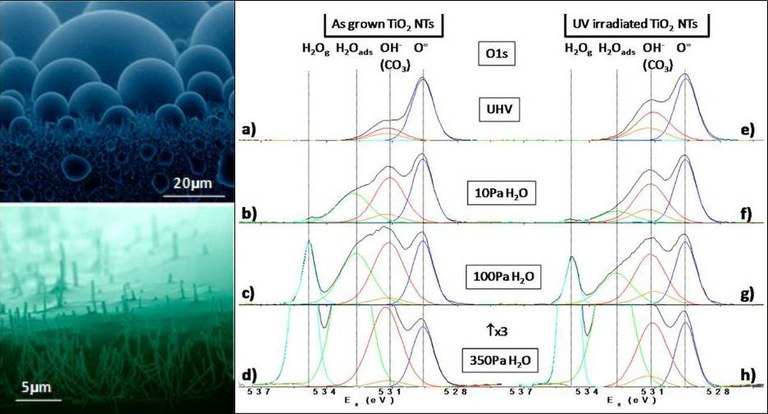Cerdanyola del Vallès, 28th March 2018. Titanium dioxide is a photoactive material whose behaviour in front of the water can be controlled simply with ultraviolet light. After UV-irradiation it changes from a hydrophobic state (water repellent) to hydrophilic (with affinity to water). This property is reversible, so it gives the possibility to tune the material’s attraction to water depending on what interests to its possible applications. For instance, in transport or architecture this kind of materials offers a wide range of possibilities to produce antifogging surfaces.
This hydrophobic/hydrophilic behaviour of titanium dioxide upon UV-light is already well known, however, there is a controversy generated about the origin of the photoinduced changes and which new effects are produced on the nanostructures such as nanotubes. In order to have a deeper insight; the researchers of the Materials Science Institute of Seville have carried out an unprecedented combination of two techniques to gather complementary information at different scales.
On one side, the scientist team used an environmental scanning electron microscope, which enables to observe the materials in situ, in conditions closed to the real ones. Images of the water condensed on the nanotubes surface were obtained (Fig.1). When the surface of the titanium dioxide is hydrophobic, the water is condensed on the external surface in droplets form, minimising the contact surface with the nanotube. After the UV-irradiation, cause of the new affinity to water of the material, a water film-wise condensation occurs, “flooding” the nanotube from the inside part to the outside of the system.

Fig.1. LEFT: Scanning electron microscope’s images of water condensed on the titanium dioxide nanotubes surface, in the hydrophobic state (above) and hydrophilic (below). Above, water droplets are shown on the nanotubes surfaces; below, it can be observed the water morphology change into a continuous film that floods all the nanostructure, after UV-irradiation.
RIGHT: Photoemission spectra obtained in ALBA Synchrotron, in vacuum conditions (a) and under an increasingly water vapour pressure to induce the progressive condensation, on nanotubes not irradiated yet (left) and after UV-irradiation (right).
With the aim of discover which mechanisms are related with these changes on water condensation, the Seville’s researcher team have analysed the titanium dioxide nanotubes at the ALBA Synchrotron, in the NAPP end-station from CIRCE beamline, which permits to perform near ambient pressure photoemission analysis. This technique with synchrotron light has given the possibility to know the chemical composition of the nanotubes surface and how this surface changes upon progressive water condensation process. Figure 1 (right) shows surface nanotubes spectra beforehand and after ultraviolet light irradiation. When water vapour is introduced to induce condensation on the titanium dioxide, it is observed less water signal in the irradiated sample, confirming that in the hydrophilic nanotubes the water condensation goes inside out. As a whole, with the photoemission spectra obtained in ALBA Synchrotron, scientists have deduced in which form water can be found on the surface and they have also observed how its adsorption changes before and after treat titanium dioxide with UV-light.
These results fit with the previous ones obtained with the scanning electron microscope. In this way, this combined technique has enabled the scientists to unravel the factors controlling the water condensation phenomena on nanotubes surfaces at both the microscopic and molecular levels. They also provided further information to understand the photoactivation processes of titanium dioxide, material that constitutes the paradigm of photoactive oxides, widely used for the development of photocatalysts, biomaterials and self-cleaning surfaces.
Reference: Manuel Macias-Montero, Carmen Lopez-Santos, A. Nicolas Filippin, Victor J. Rico, Juan P. Espinos, Jordi Fraxedas, Virginia Perez-Dieste, Carlos Escudero, Agustin R. Gonzalez-Elipe and Ana Borras. In Situ Determination of the Water Condensation Mechanisms on Superhydrophobic and Superhydrophilic Titanium Dioxide Nanotubes. Langmuir (2017), 33, 6449-6456.




